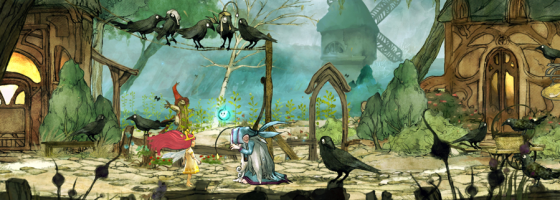Reading reviews of Child of Light, I noticed that supporters of the game argued against poor scores on the grounds that the game’s aesthetic value should compensate for any problems or criticisms of the design. This is the common defense of games with a focus on storytelling or graphics and are commonly referred to as “art games”. That any issues design wise should be ignored or not graded as harshly if the game was trying to do something different.
The debate whether or not video games are considered art has been going on for what seems like forever and it’s time to finally declare that video games are not art… at least in the form that people say it is.
Playable Art?
Art games have been gaining momentum among indie developers with major examples being the games from Tale of Tales, Dear Esther or Gone Home to name a few. Due to their focus on storytelling as opposed to design, you can do a lot with very little as long as the graphics are consistent and the game doesn’t have any game breaking bugs.
The focus of these titles is commonly on the storytelling and where the bulk of the development is focused on. But then there are cases like Child of Light where you can see that there was a lot of focus on the game’s art style.
“Art Games” are the titles that give the most sway to the “games as art” argument as they are more often the games that move people emotionally. The story of Gone Home which I’m not going to spoil here, touched a lot of people with its message and theme.
And it’s hard not to agree with those people when you look at how these games were made. An art game is rarely made by a major developer or a corporate person, but by people with a passion who really wanted to make this game in this explicit way.
However having played so many games over the years, I have to argue against the common opinion that I mentioned earlier for two reasons.
Being Productive:
First is that every video game no matter who makes them is always a product first. Now you can say that you were trying to tell a specific story or experiment in some way, but the minute you put a price tag on your title, you are selling it. And yes it’s fair to say that you were trying to make an artistic piece, but there is still the second purpose of making a product to sell.
One of the biggest shifts that you need to make when moving from being an enthusiast to a designer is that you also become a marketer and it’s your job to sell your game to people. Saying that you just want to make art games and don’t care if they are sold or pirated may sound good in theory, but unless you have a secondary source of income you won’t be in the industry for long.

Gone Home’s story for many people was worth the $20 price tag despite not having all that much to do in it.
The other point has to do with gameplay and the perception that if a game is being targeted as an art piece that it should be immune to criticism.
Again this goes back to the previous point and how if you’re trying to sell a product, then it’s simply not immune to criticism.
The flip side of “art games” and where people mark them down for is usually in the gameplay department. Either there isn’t much there, controls don’t work that well or simply that the game is really short. Basically if you find elements that you don’t like that you would criticize in any other title, then the fact that this is an art game shouldn’t make those issues disappear.
This also brings up the issue of the pricing which itself is way too big to go into too much about here. With Gone Home despite having an interesting story, the game was only a few hours long and was originally priced at $20. For many people including me, we felt that was very high for what was there. But the counter argument was that despite what the game was in terms of design, the story was worth $20 to them.
Again, something is worth what someone is willing to pay and for people looking for a unique story, Gone Home was worth $20 to them. But as with the gameplay, you can’t ignore price when making a critical analysis. However the subject of game value is still one that is being debated and there hasn’t been any precedence set as to what a game should be worth.
Designing Art:
To wrap things up I want to return to the original question: Are Games Art? While over the course of this post I debated against the common view of the argument, but I do feel that there is an area where video games can be seen as art. For me, it has to do with excellently crafted game design, something that I want to go back to over and over again simply because I wanted to experience it again.
Some examples would be Demon’s Souls, Mario Galaxy and The Binding of Isaac. Each game I enjoyed to its fullest and wanted to keep playing thanks to how well designed it was.
It’s the same viewpoint of people who love cars and how everything comes together to deliver an amazing piece of hardware.
So while something may look good, it’s how the design works that interests us. Or how someone who appreciates intricate machinery may view something like pocket watches as art.
But it’s important to realize that those examples I mentioned despite me calling their design art, they are still products first and foremost. Each one was an excellent game with design that holds up under scrutiny. And they were designed both because the team wanted to make them and because they wanted to hopefully make a profit.
The Game Industry has certainty expanded over the years and now you have everyone from Indie teams made up of four or five people to AAA studios with teams in the hundreds. And while the definition of a game has changed, it’s important to remember that no matter who you are, the second you put a price on your game you are a seller and your game is a product and will be judged as such.



Pingback: Art vs Monetization | Game Wisdom()